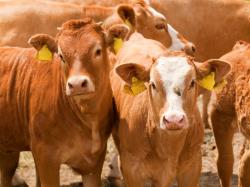Collaboration Key To Antibiotic Stewardship
December 8, 2015 | 3 min to read

Human and animal health experts came together in Atlanta, Georgia Nov. 3-5 to discuss issues related to antibiotic resistance and to work toward increased antibiotic stewardship in human medicine and animal health. Throughout the dialogue, attention focused on specific areas that can be measured to verify progress made in reducing antimicrobial resistance.
Convened by the National Institute for Animal Agriculture (NIAA) and sponsored in part by the beef checkoff, the national symposium brought together a broad cross-section of professionals to share relevant science and develop consensus on those key areas in which the most progress can be made.
“Antibiotics have been critical in human and veterinary medicine since the 1940’s and antibiotic resistance has been a challenge almost as long,” said Dr. Robert Tauxe, deputy director of the Division of Foodborne, Waterborne and Environmental Diseases, National Center for Emerging and Zoonotic Infectious Diseases at the Centers for Disease Control and Prevention (CDC). “Thus, with the ever-changing antibiotic landscape, research, education and constantly improving stewardship is imperative.”
“Stewardship is a cycle, not something we do and then forget,” said Dr. Mike Apley, professor of production medicine and clinical pharmacology at Kansas State University. “Stewardship is a commitment to a cycle.”
With increased antibiotic stewardship comes a greater need for more detailed recordkeeping and data management. “Emphasis on treatment records will be relied upon like they never have been before,” Apley said. “Increased federal regulations and requirements on veterinary feed directives and veterinary-client-patient relationships, producers and veterinarians will have to keep treatment records like they do their finances.”
Key stakeholders in the battle against antimicrobial resistance within the livestock and human-health communities developed pathways to accomplish this goal. Under the direction of Tom Chapel, chief evaluation officer for the CDC, participants worked in groups to develop a roadmap to decrease antibiotic resistance while continuing to provide a safe and adequate food supply.
All sides of the table were represented in these discussions, including the retail community. Representatives from Costco, Tyson Foods and Yum Brands shed light on what the consumers are demanding and what they are doing to answer those demands.
“For consumers, this is not a scientific discussion, it is an emotional one,” said Donnie Smith, chief evaluation officer of Tyson Foods. Parents want to know that they are doing the right thing for their children and, that when their children need an antibiotic, that it is going to be effective.
This requirement also is being asked of the human-health community, making it a no-brainer for veterinary and human-health communities to work together. “Challenges are really too complex for any group to address alone,” said Dr. Arjun Srinivasan, associate director for healthcare associated infection prevention programs in the Division of Healthcare Quality Promotion at the CDC.
The production of the symposium’s proceedings will be available soon at animalagriculture.org, and a white paper on the event will be available by the end of 2015.
For more information about your beef checkoff investment, visit MyBeefCheckoff.com.
UNDERSTANDING THE BEEF CHECKOFF PROGRAM
The Beef Checkoff Program was established as part of the 1985 Farm Bill. The checkoff assesses $1 per head on the sale of live domestic and imported cattle, in addition to a comparable assessment on imported beef and beef products. States may retain up to 50 cents on the dollar and forward the other 50 cents per head to the Cattlemen's Beef Promotion and Research Board, which administers the national checkoff program, subject to USDA approval.
Source: The Beef Checkoff Program
